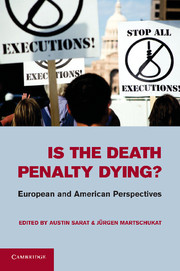Book contents
- Frontmatter
- Contents
- Contributors
- Acknowledgments
- Introduction: Transatlantic Perspectives on Capital Punishment
- PART I WHAT IS A PENALTY OF DEATH: CAPITAL PUNISHMENT IN CONTEXT
- 1 The Green, Green Grass of Home
- 2 Did Anyone Die Here?
- 3 Capital Punishment as Homeowner's Insurance
- Part II ON THE MEANING OF DEATH AND PAIN IN EUROPE AND THE UNITED STATES: VIEWING, WITNESSING, UNDERSTANDING
- Part III ABOLITIONIST DISCOURSES, ABOLITIONIST STRATEGIES, ABOLITIONIST DILEMMAS: TRANSATLANTIC PERSPECTIVES
- Index
- References
2 - Did Anyone Die Here?
Legal Personalities, the Supermax, and the Politics of Abolition
Published online by Cambridge University Press: 04 February 2011
- Frontmatter
- Contents
- Contributors
- Acknowledgments
- Introduction: Transatlantic Perspectives on Capital Punishment
- PART I WHAT IS A PENALTY OF DEATH: CAPITAL PUNISHMENT IN CONTEXT
- 1 The Green, Green Grass of Home
- 2 Did Anyone Die Here?
- 3 Capital Punishment as Homeowner's Insurance
- Part II ON THE MEANING OF DEATH AND PAIN IN EUROPE AND THE UNITED STATES: VIEWING, WITNESSING, UNDERSTANDING
- Part III ABOLITIONIST DISCOURSES, ABOLITIONIST STRATEGIES, ABOLITIONIST DILEMMAS: TRANSATLANTIC PERSPECTIVES
- Index
- References
Summary
My subject is solitary confinement and the ways in which it has been transmuted from an occasional tool of disciplinary convenience in our prisons – as punishment for infractions – into a widespread, normative, but concealed alternative death penalty in our judicial system. Although issues of punishment and conditions of confinement in our prisons are two separate subjects, they come together and overlap in the ways we treat criminals.
Recent judicial activism – I think particularly of Justices Antonin Scalia and Clarence Thomas – has tried to remove conditions of confinement from Eighth Amendment scrutiny, making them part of the administrative prerogative, and hence to narrow the definition of punishment, thus emptying it of much of its actual, lived meaning. However, whether we regard prison as retributive or as rehabilitative, or as both, conditions of confinement do matter, not simply as an administrative issue or as an Eighth Amendment issue, but because, quantitatively and qualitatively, they have changed their character and in doing so changed the character of punishment – as well as the status of the condemned. Newer and ever larger categories of our population are swept up into the categories of the dehumanized and excluded.
Once, solitary confinement affected relatively few prisoners for relatively short periods of time. Today, most prisoners can expect to face solitary, for longer periods than before, and under conditions that make old-time solitary seem almost attractive. The costs are enormous.
- Type
- Chapter
- Information
- Is the Death Penalty Dying?European and American Perspectives, pp. 47 - 77Publisher: Cambridge University PressPrint publication year: 2011



